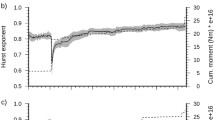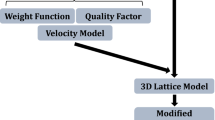Abstract
Based on the aftershock sequence of the Great Wenchuan earthquake that occurred on 12 May, 2008, the long-term memory and multifractal scaling are analyzed by using MF-DFA method. And we consider aftershocks as a SOC phenomenon. Main findings are as follows: (1) hq values of the aftershock sequence indicates high persistence or long-term memory. (2) The generalized fractal dimensions D(q) presents obvious trend variation, which reveal crisis and critical characteristics of seismogenic dynamical system. (3) The right-skewed spectrum f(α) indicates that the aftershocks are predominated by low magnitude, which gives a characterization of distribution in multiple scales in seismic activity. Its structural morphology is closely related with the dynamical complexity. (4) Aftershock sequence exhibits self-organized criticality because it follows the classical Gutenberg-Richter and Omori Law.
Similar content being viewed by others
References
An, Z.W., Yang, C.H., Wang, LY. and Chen, L.H. (2000) Studies on the multifractals of time and space clustering of earthquakes. Sci. China, Ser. D: Earth Sci., v.43, pp.74–80.
Bak, P., Christensen, K., Danon, L. and Scanlon, T. (2002) Unified scaling law for earthquakes. Phys. Rev. Lett., v.88, pp.178501–178504.
Bak, P. and Tang, C. (1989) Earthquakes as a self-organized critical phenomenon. Jour. Geophys. Res., v.94, pp.15635–15637.
Bak, P., Tang, C. and Wiesenfeld, K. (1987) Self-organized criticality: An explanation of the 1/f noise. Phys. Rev. Lett., v.59, pp.381–384
Bak, P., Tang, C. and Wiesenfeld, K. (1988) Self-organizing criticality. Phys. Rev. A, v.38, pp.364–374.
Boffetta, G., Carbone, V., Giuliani, P., Veltri, P. and Vulpiani, A. (1999) Power laws in solar flares: self-organized criticality or turbulence? Phys. Rev. Lett., v.83, pp. 4662–4665.
Carlson, J.M. and Langer, J.S. (1989) Properties of earthquakes generated by fault dynamics. Phys. Rev. Lett., v.62, pp.2632–2635.
Chen, K., Bak, P. and Obukhov, S.P. (1991) Self-organized criticality in a crack-propagation model of earthquakes. Phys. Rev. A, v.43, pp.625–630.
Clarke, A.B. (1956) A waiting line process of Markov type. Ann. Math. Statist., v.27, pp.452–459
Cowie, P., Vanneste, C. and Sornette, D. (1993) Statistical physics model for spatio-temporal evolution of faults. Jour. Geophys. Res., v.98, pp.21809–21821.
Feder, J. (1988) Fractals. Plenum Press, New York. pp 463.
Godano, C., Alonzo, M.L. and Volardo, G. (1997) Multifractal approach to time clustering of earthquakes. Application to Mt.Vesuvio Seismicity. Pure Appld. Geophys., v.149, pp.375–390.
Guo, Z. and Ogata, Y. (1997) Statistical relations between the parameters of aftershocks in time, space and magnitude. Jour. Geophys. Res., v.102, pp.2857–2873.
Gutenberg, B. and Richter, C.F. (1944) Frequency of earthquakes in California. Bull. Seismol. Soc. Am., v.34, pp.185–188.
Gutenberg, B. and Richter, C.F. (1956) Earthquake magnitude, intensity, energy and acceleration (second paper). Bull. Seismol Soc. Amer., v.46, pp.105–145.
Halsey, T. C., Jensen, M.H., Kadanoff, L.P., Procaccia, I. and Shraiman, B. I. (1986). Fractal measures and their singularities: the characterization of strange sets. Phys. Rev. A, v. 33, pp.1141–1151.
Huang, Y., Wu, J.P., Zhang, T.Z. and Zhang, D.N. (2008) Relocation of the M 8.0 Wenchuan earthquake and its after-shock sequence. Sci. China, Ser. D, Earth Sci., v.51, pp.1703–1711.
Ito, K. and Matsuzaki, M. (1990) Earthquakes as a self-organized critical phenomena. Jour. Geophys. Res., v.95, pp. 6853–6860.
Kagan, Y.Y. (1992) Correlations of earthquake focal mechanism. Geophys. Jour. Internat., v.110, pp.305–320.
Kagan, Y.Y. and Jackson, D.D. (1991) Long-term earthquake clustering. Geophys. Jour. Internat., v.104, pp. 117–133.
Kagan, Y.Y. (1994) Observational evidence for earthquakes as a nonlinear dynamic process. Physica D, v.77, pp.160–192.
Kantelhardt, J.W., Zschiegner, S.A., Koscielny-Bundec, E., Havlind, S., Bundea, A. and Stanleyb, H.E. (2002) Multifractal detrended fluctuation analysis of nonstationary time sequence. Physica A, v.316, pp.87–114.
Kisslinger, C. (1996) Aftershocks and fault-zone properties. Adv. ai]Geophys., v.38, pp.1–36.
Lei, X.L. (2003) How do asperities fracture? An experimental study of unbroken asperities. Earth Planet. Sci. Lett., v.213, pp.347–359.
Li, L., Chen, Q.F., Cheng, X. and Niu, F.L. (2007) Spatial clustering and repeating of seismic events observed along the 1976 Tangshan fault, north China. Geophys. Res. Lett., v.34, pp.L23309.
Liu, Z.H., Xu, J.H., Chen, Z.S, Qie, Q. and Wei, C.M. (2014a) Multifractal and long memory of humidity process in the Tarim River Basin. Stoch. Environ. Res. Risk. Assess., v.28, pp.1383–1400.
Liu, Z.H., Xu, J.H. and Shi, K. (2014b) Self-organized criticality of climate change. Theory Appld. Climatol., v.115, pp.685–691.
Matsoukas, C., Islam, S. and Rodriguez-Iturbe, I. (2000) Detrended fluctuation analysis of rainfall and streamflow time series. Jour. Geophys. Res., v.105, pp.29165–29172.
Nanjo, K., Nagahama, H. and Satomura, M. (1998) Rates of aftershock decay and the fractal structure of active fault systems. Tectonophysics, v.287, pp.173–186.
Rodney, J.B. (1972) Partition function of the eight-vertex lattice model. Annals of Physics, v.70, pp.193–228.
Shi, K., Liu, C.Q., Ai, N.S. and Zhang, X.H. (2008) Using three methods to investigate time-scaling properties in air pollution indexes time series. Nonlin. Anal.: Real World Appl., v.9, pp.693–707.
Shi, K., Liu, C.Q., Huang, Z. W., Zhang, B. and Su, Y. (2010) Comparative analysis of time-scaling properties about water pH in Poyang Lake inlet and outlet on the basis of fractal methods. Wat. Sci. Tech., v.61, pp. 2113–2118.
Smalley, R. F., Chatelain, J.L., Turcotte, D.L. and Prevot, R. (1987) A fractal approach to the clustering of earthquakes: applications to the seismicity of the New Hebrides. Bull. Seism. Soc. Am., v.77, pp.1368–1381.
Sornette, A. and Sornette, D. (1989) Self-organized criticality and earthquakes. Europhys. Lett., v.9, pp.197–202.
Sornette, A., Dubois, J., Cheminée, J.L. and Sornette, D. (1991) Are sequence of volcanic eruptions deterministically chaotic? Jour. Geophys. Res., v.96, pp.11931–11945.
Sornette, D., Davy, P. and Sornette, A. (1990) Structuration of the lithosphere in plate tectonics as a self-organized critical phenomena. Jour. Geophys. Res., v.95, pp.17353–17361.
Telesca, L., Lapenna, V. and Alexis, N. (2004) Multiresolution wavelet analysis of earthquakes. Chaos, Solitons and Fractals, v.22, pp.741–748.
Thanassoulas, C. (2008) The seismogenic area in the lithosphere considered as an “Open Physical System”. Its implications on some seismological aspects. Part-II. Maximum expected magnitude determination. ar**v:0807.0897 [physics. geo-ph].
Tselentis, G. (1997) Contemporary seismology. Seismic Energy, v.2, pp.511–514.
Turcotte, D.L. (1990) Fractal and Chaos in Geology and Geophysics. Cambridge University Press. pp.221.
Vandewalle, N., Ausloos, M. and Boveroux, P.H. (1999) Applications of statistical physics to economic and financial topics. Physica A, v.269, pp.170–176.
Yang, X.S., Du, S.M. and Ma, J. (2004) Do earthquakes exhibit self-organized criticality? Phys. Rev. Lett., v.92, pp.228501–228504.
Author information
Authors and Affiliations
Corresponding author
Rights and permissions
About this article
Cite this article
Daohong, L., Qiang, X. Analysis of time-scaling behaviour in the sequence of aftershocks of the Wenchuan earthquake, China. J Geol Soc India 84, 361–369 (2014). https://doi.org/10.1007/s12594-014-0140-0
Published:
Issue Date:
DOI: https://doi.org/10.1007/s12594-014-0140-0




